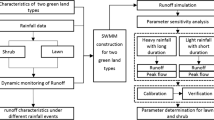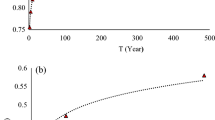Abstract
The different peak discharge value estimated in the rational method (RM) model is caused by the various methods used to determine the runoff coefficient (C) parameter. The C value can be defined as the total amount of rainfall generated to become the runoff. Various studies have been conducted to produce C values that differ from one to another. For example, the C values suggested by the Manual of Storm Water Management (MSMA) and the American Society of Civil Engineers (ASCE) differed. To estimate C values, land use classification is confusing, unorganized, and not uniform, and therefore, the application of suggested C value is still doubtful to be applied in Malaysia. Thus, this research focused on estimating the C value based on the land use classification for urban areas in Penang using a rainfall simulator. The runoff coefficient will be generated from various surface types at a plot scale representing urban land use. The result obtained shows that the C values were 0.79–0.89 (asphalt), 0.85–0.92 (concrete), 0.77–0.89 (zinc), 0.73–0.85 (brick), 0.85–0.96 (asbestos), 0.8–0.93 (tiled roof), 0.17–0.63 (grass 2°–7°), and 0.35–0.69 (bare soil 2°–7°). The variation of the C value was influenced by the total amount of rainfall, surface imperviousness, soil moisture, soil and surface characteristics, slope, and vegetation cover. There were significant differences in the C value obtained in this study compared to the C value of MSMA (asphalt and brick) and the C value of ASCE (concrete and asbestos, grass, and exposed soil). Four factors that influenced the differences of C values in this research were environmental conditions, namely scale, surface physical condition, and soil antecedent moisture. The multiple comparison test showed a significant difference in the peak discharge estimated using RM compared to the gauged peak discharge. Nevertheless, peak discharge estimated from various C values in the RM did not show any statistical differences. In conclusion, this study found that the rainfall simulator could be used as a suitable and efficient modus operandi in terms of cost and time for runoff studies.





Similar content being viewed by others
Data availability
Not applicable.
Code availability
Not applicable.
References
Abu-Ashour J, dan Lee, H. (2000) Transport of bacteria on sloping soil surfaces by runoff. Environ Toxicol 15:149–153
American Society of Civil Engineers, ASCE (1969) Design and construction of sanitary and storm sewers. Manual and Reports on Engineering Practice No. 37. New York.
Ben-Zvi A (1989) Toward a new rational method. J Hydraul Eng 115(9):1241–1255
Cardoso, T., Machado, R., & Mortene, M. (2019). Determination of the runoff coefficient (C) in catchments based on analysis of precipitation and flow events. https://doi.org/10.20944/preprints201907.0208.v1
Christiansen, J.E. (1942) Irrigation by sprinkling. California Ag Expt Sta Bulletin 670, University of California, Berkeley, CA
Croke J, Mockler S, Fogarty P, Takken I (2005) Sediment concentration changes in runoff pathways from a forest road network and the resultant spatial pattern of catchment connectivity. Geomorphology 68:257–268
Davidová, T., Dostál, T., David, V., & Strauss, P. (2015). Determining the protective effect of agricultural crops on the soil erosion process using a field rainfall simulator. Plant Soil and Environment, 61, 109–115. https://doi.org/10.17221/903/2014-PSE
DeBano LF (2000) Water repellency in soils: a historical overview. J Hydrol 231–232:195–206
Department of Irrigation and Drainage, Malaysia. Urban Stormwater Management Manual for Malaysia, Kuala Lumpur: PNMB, Chapter 13, pp. 1–2; Chapter 14, pp.1 – 24, 2000.
Duncan MJ (1972) The performance of a rainfall simulator and an investigation of plot hydrology. MAgrSc thesis. University of Canterbury, New Zealand
Hayes, D. C. dan Young, R. L. (2006) Comparison of peak discharge and runoff characteristic estimates from the rational method to field observations for small basins in central Virginia. USGS Scientific Investigation Report, 2005–5254
Herngren, L., Goonetilleke, A. dan Ayoko, Godwin. (2004) Investigation of urban water quality using artificial rainfall. Proceedings of the International Conference: Watershed 2004, Dearborn, Michigan, CD Rom Publication.
Hudson NW (1963) Raindrop size distribution in high intensity storms. Rhodesian Journal of Agricultural Research 1:6
Hudson, N.W. (1965) The influence of rainfall on the mechanics of soil erosion, MSc thesis, University of Cape Town.
Kadioglu M, ŞEN Z (2001) Monthly precipitation-runoff polygons and mean runoff coefficients. Hydrol Sci J 46(1):3–11
Kafy, A.A., Faisal, A-A., Raikwar, V., Al Rakib, A., Kona, M.A. and Ferdousi, J., 2021. Geospatial approach for developing an integrated water resource management plan in Rajshahi, Bangladesh. Environmental Challenges, 4, p.100139.
Keya, D., & Hama Karim, T. (2020). Simulation of rainfall intensity and slope gradient for determination of soil runoff coefficient at micro-plot scale. https://doi.org/10.25156/ptj.v10n1y2020.pp12-1
Kuichling E (1889) The relation between the rainfall and the discharge of sewers in populous districts. Trans. ASCE 20:1–60
Lawrence AI, Marsalek JB, Ellis JB, Urbanos B (1996) Storm-water detention and BMPs. J Hydraul Res 34(6):719–813
McCune RH, Wong SL, dan Rawls, W.J. (1984) Estimating urban time of concentration. J Hydr Engrg 110(7):887–904
Merz R, Blöschl G, dan Parajka, J. (2006) Spatio-temporal variability of event runoff coefficients. J Hydrol 331:591–604
Roesner, L. A. (1999) The hydrology of urban runoff quality management. Dalam In Sustaining Urban Water Resources in the 21st century. Edited by Rowney, A. C. et al., ASCE
Sen S, Srivastava P, Yoo KH, Dane JH, Shaw JN, Kang MS (2008) Runoff generation mechanisms in pastures of the Sand Mountain region of Alabama—a field investigation. Hydrol Process 22(21):4222–4232
Schueler TR (1987) Controlling urban runoff: a practical manual for planning and design urban BMPs. Washington Council Governments, Washington DC
Tew Kia Hui (1999) Production of Malaysian soil erodibility nomograph in relation to soil erosion issues. VT Soil Erosion Research & Consultancy. Selangor, Malaysia
Walsh CJ (2000) Urban impacts on the ecology of receiving waters: a framework for assessment, conservation and restoration. Hydrobiologia 431:107–114
Young CB, McEnroe BM, Rome AC (2009) Empirical determination of rational method runoff coefficients. J Hydrol Eng 14(12):1283–1289
Acknowledgements
The author would like to thank Abdulla – Al Kafy, Abdullah-Al-Faisal, and Dynamic Institute of Geospatial Observation Network (DIGON) research and consultancy firm experts for proofreading the entire manuscript and doing language editing.
Funding
This study is financially supported by the Ministry of Higher Education Malaysia (Fundamental Research Grant Scheme FRGS 203/PHUMANITI/671012).
Author information
Authors and Affiliations
Contributions
The author was responsible for the full manuscript preparation.
Corresponding author
Ethics declarations
Conflict of interest
The authors declare no competing interests.
Additional information
Communicated by Broder J. Merkel
Rights and permissions
About this article
Cite this article
Rahaman, Z.A. Runoff coefficient (C value) evaluation and generation using rainfall simulator: a case study in urban areas in Penang, Malaysia. Arab J Geosci 14, 2168 (2021). https://doi.org/10.1007/s12517-021-08575-1
Received:
Accepted:
Published:
DOI: https://doi.org/10.1007/s12517-021-08575-1




